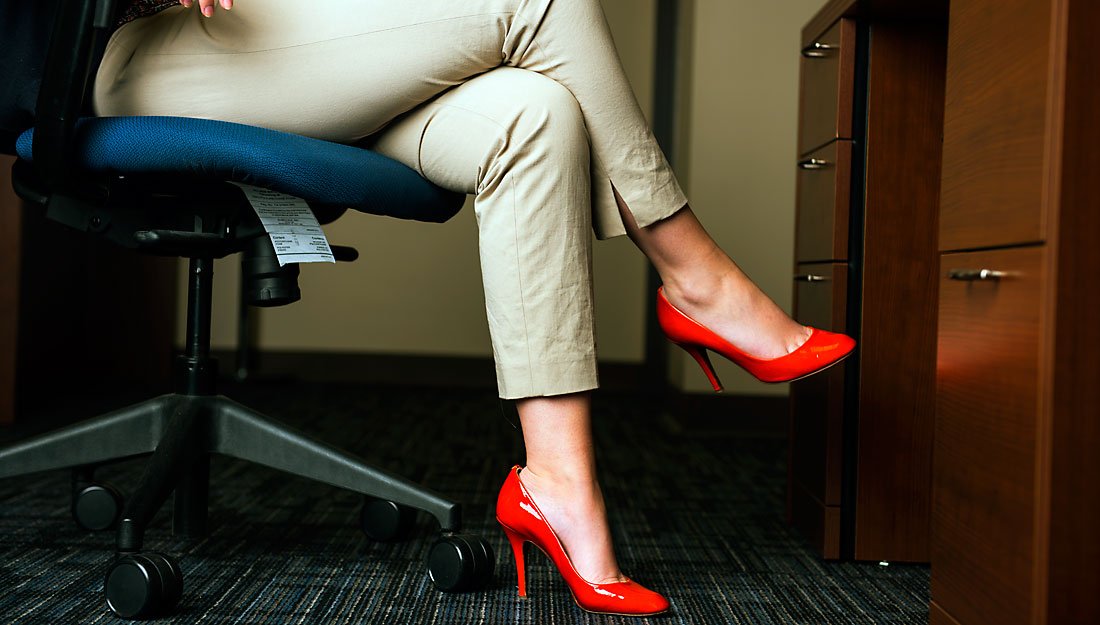- Madison Matous
- Medicine, Show on VR homepage, Trending
Healthy legs: Preventing circulation problems on the job

Our legs go under cover as the weather turns colder – but that doesn’t mean you shouldn’t give them a second glance this fall and winter. Symptoms of poor circulation normally begin with your legs. Here’s why “getting your blood going” is so important for your health.
According to Ruth Bush, M.D., J.D., M.P.H., vice dean for academic affairs and professor of surgery at the Texas A&M Health Science Center College of Medicine, there are many reasons behind poor circulation, and luckily, a lot of healthy ways to combat it—especially on the job.
Don’t be chained to your desk
“Working at a desk all day gets a bad rap, and for good reason,” Bush said. “Sitting for extended periods of time has been linked to heart disease, high blood pressure, obesity, poor posture and more. Sitting in the same position for hours, like in a chair where the body is bent at the hips and knees, can block blood from getting back to the heart, and may even cause your legs to become swollen.”
But, even if you stand most of the day that doesn’t mean you’re out of the woods.
While standing desks are a popular way to fight the sitting epidemic, Bush said the goal shouldn’t be for a person to stand all day – instead, focus on not sitting for the majority of the workday.
“Standing desks are great for posture, but even people who stand should remember to take breaks,” she said.
To prevent poor circulation, Bush suggests leaving the desk and walking around periodically–about every 45 minutes. “This is a good chance for you to say hello to co-workers, grab coffee or use the restroom,” she said. “These breaks give both your mind and body a reprieve.” She said propping your feet up throughout the day will also increase circulation.
Planes, trains, automobiles and veins
Traveling and long commutes to work have become a norm, but sitting for hours on end in planes, trains and automobiles causes more than jet lag and stiff limbs.
Deep vein thrombosis (DVT), also known as economy class syndrome, is the development of a blood clot in the deep veins of your thighs or calves, which can result in muscle pain, swelling, tenderness and redness.
“These kind of clots are not usually dangerous unless the clot travels to your lungs causing a pulmonary embolism resulting in chest pains, trouble breathing and in extreme cases death,” Bush said.
To guard against deep vein thrombosis, follow these tips on your next long trip:
- Wear travel compression socks, which can help blood flow and prevent clotting
- Get up and walk around at least every two hours, whether that means getting up to go to the bathroom, to stretch your legs when the plane is cruising, or stopping at a gas station for a snack
- Drink plenty of water and avoid alcoholic and caffeinated drinks that are dehydrating
In the same vein–spider and varicose veins
Sitting or standing all day at work–whether you’re traveling or not has another unwelcome side effect: spider veins and varicose veins
Spider veins are the less serious version of the condition and merely a cosmetic annoyance, but varicose veins are bigger and can be painful.
Varicose veins are defined as abnormally enlarged veins with faulty valves. When these valves fail to work, blood tends to pool, causing increased pressure and stretching of the veins–giving them a ropy appearance.
Working women love their high heels, however, this fashion choice could be a mistake in the long run. High heels can contribute to the risk of developing spider veins by forcing the ankles to bend forward and restrict blood flow to the legs. This doesn’t mean you can’t ever wear high heels, but women who wear them daily may want to consider giving their legs a much-needed break.
Surprisingly, Bush found another working group susceptible to the development of varicose veins at an early age: Deployed soldiers and combat veterans.
“At the United States Department of Veterans Affairs (VA) hospitals, we found young veterans who were oversees in Iraq and Afghanistan developed this condition early,” she said. “This could be because they often wore heavy gear–up to 100 pounds of equipment.”
This is the same reason that people who are overweight or are pregnant are more at risk, because the increase of weight on your legs increases the volume in your blood vessels.
To help reduce your risk of developing varicose veins, Bush recommends exercising, eating healthy and maintaining an ideal weight. “When you exercise you are squeezing those muscles and as they are contracting they are pumping blood back to your heart, which improves your blood flow in your legs.”
“It doesn’t matter if you work a desk job, travel the world for a living, or are on your feet all day –we all need to be aware of the symptoms and consequences of poor circulation. ‘Getting your blood pumping’ is more than just an old adage, it’s a healthy living practice,” she said.
Media contact: media@tamu.edu


